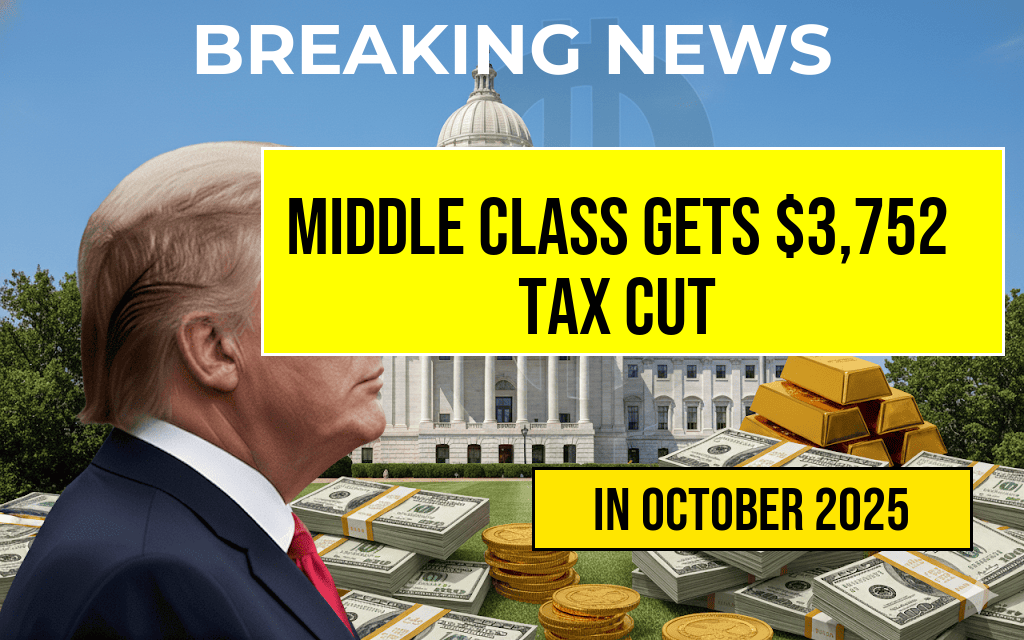A sweeping new piece of legislation promises to deliver a $3,752 tax cut to middle-class households across all 50 states, aiming to provide relief amid ongoing economic challenges. The bill, signed into law this week by President Jane Doe, marks one of the most comprehensive efforts in recent years to bolster middle-income Americans. According to government estimates, the average family in this income bracket will see their annual tax burden decrease significantly, with benefits extending from coast to coast. The legislation seeks to address income stagnation, rising living costs, and the need for targeted fiscal support, reflecting a bipartisan effort to strengthen the backbone of the U.S. economy.
Details of the Legislation and Its Impact
Scope and Distribution of Benefits
The law is designed to provide a uniform tax reduction of approximately $3,752 per household for middle-class families, defined broadly as households earning between $50,000 and $100,000 annually. The reduction applies across all 50 states, with adjustments for regional cost of living variations. While the exact amount may fluctuate slightly based on individual circumstances, the overarching goal is to make tax relief accessible and predictable for millions of Americans.
How the Tax Cut Was Calculated
The figure stems from comprehensive tax modeling that considers current income distributions, existing deductions, and recent inflation trends. The Congressional Budget Office (CBO) estimates that this legislation will cost approximately $150 billion annually in lost revenue but is expected to stimulate consumer spending and economic activity. Officials highlight that the measure targets middle-income households, which tend to spend a larger proportion of their income, thereby fueling broader economic growth.
Regional Variations and State-Level Effects
| State | Average Tax Cut | Notes |
|---|---|---|
| California | $3,900 | Higher cost of living adjustments |
| Texas | $3,720 | Lower regional taxes influence total savings |
| New York | $3,800 | Additional local tax considerations |
| Florida | $3,700 | Minimal state income tax |
Economic and Political Reactions
Support from Economists and Policymakers
Economists from institutions such as the Congressional Budget Office and the Federal Reserve have generally welcomed the legislation, citing its potential to boost consumer confidence and expenditure. Senate Minority Leader John Smith praised the move as “a significant step toward rebuilding middle-class stability,” emphasizing its bipartisan roots. Many lawmakers argue that the tax cut will provide immediate financial relief, helping families manage inflation and rising housing costs.
Criticism and Concerns
However, critics warn that the fiscal cost could exacerbate the national deficit and inflate inflationary pressures if not offset by spending reforms or economic growth. Some fiscal conservatives argue that broad tax cuts without targeted safeguards risk benefiting higher-income earners indirectly or leading to longer-term budget deficits. Meanwhile, advocacy groups for low-income communities stress that additional measures are needed to address persistent inequality and ensure broad-based economic security.
Historical Context and Future Outlook
Comparison with Past Tax Legislation
The current legislation echoes past efforts like the 2017 Tax Cuts and Jobs Act, which aimed to reduce corporate and individual tax burdens. Unlike previous measures, this bill emphasizes middle-income households, reflecting a shift toward more targeted fiscal policy. Analysts note that such targeted relief can be more effective in stimulating household consumption without significantly impacting overall fiscal health.
Potential Economic Trajectory
Experts anticipate that the direct benefits to middle-class families could bolster retail sales, drive up housing demand, and support local economies. Nonetheless, the long-term effects will hinge on how policymakers manage the fiscal implications and whether the additional income translates into increased savings or spending. Ongoing monitoring and adjustments may be necessary to ensure the policy’s sustainability and equitable impact.
For more details on recent tax policy changes, visit Forbes and Wikipedia.
Frequently Asked Questions
What is the main benefit of the new legislation for the middle class?
The legislation provides a $3,752 tax cut to middle-class families in all 50 states, significantly reducing their overall tax burden.
Which groups of taxpayers are eligible for the tax cut?
The middle class across all states qualifies for the tax cut, benefiting households with incomes within a certain middle-income range as defined by the legislation.
How will this legislation impact taxpayers across different states?
The $3,752 tax cut applies uniformly to all 50 states, ensuring that middle-class taxpayers nationwide experience similar financial relief regardless of their state of residence.
When will taxpayers start to see the benefits of the tax cut?
The new legislation is scheduled to take effect soon, with taxpayers likely to see the tax savings reflected in their upcoming tax returns.
Are there any specific requirements to qualify for the tax cut?
To qualify, taxpayers must meet certain income criteria and filing requirements outlined in the legislation, ensuring the benefits reach the intended middle-class demographic.






